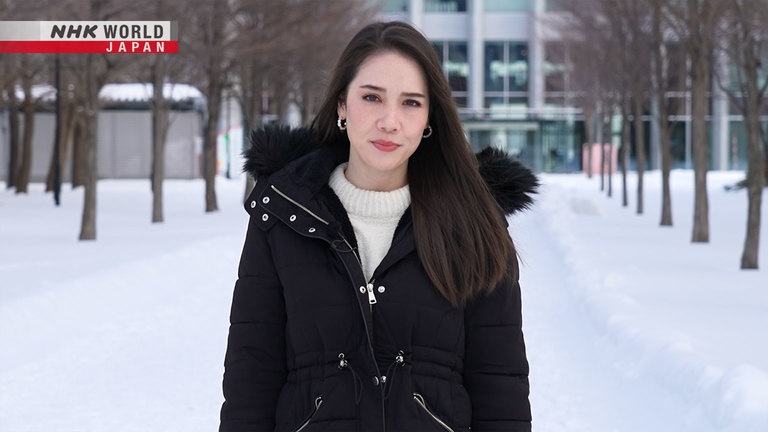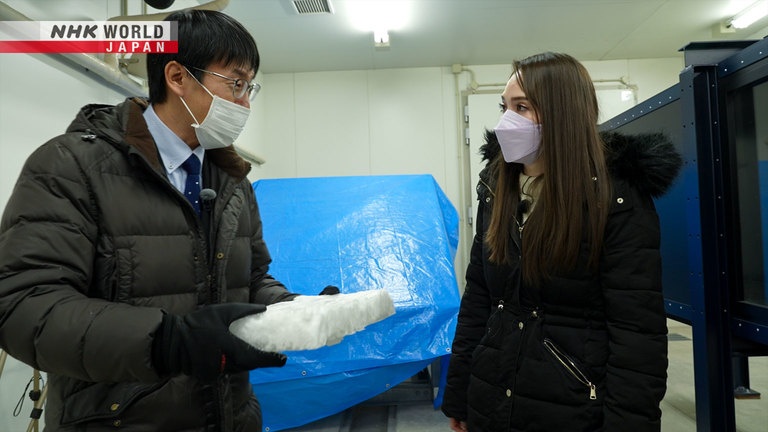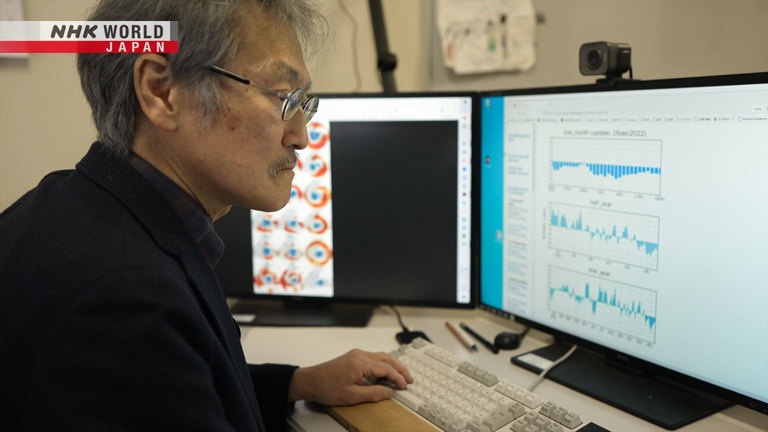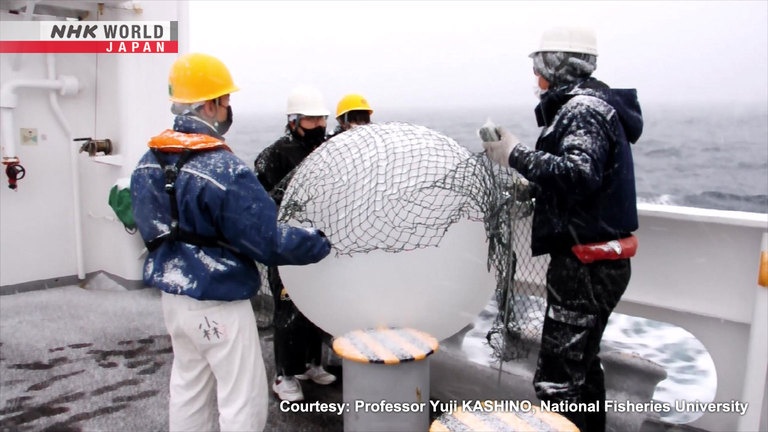#25 Heavy Snow
In recent years, heavy snow has been falling frequently in Japan. While the overall amount of snowfall per winter has been decreasing year by year, the amount of snow that falls at one time is conversely increasing. What role does climate change play in this? It turns out that rising temperatures have led to more water vapor in the Sea of Japan, and interaction with a weather phenomenon called JPCZ has subsequently brought on heavy snow. We'll examine the mechanism behind this as well as the risks of snow disasters.




Transcript
Japan has a long history of natural disaster.
Now, power of science is helping to overcome.
BOSAI: Science that Can Save Your Life.
More than half of Japan is designated as an "area of heavy snowfall."
Approximately 20 million people live in these areas.
In recent years, heavy snow which endangers peoples' lives has become a particular problem.
"Heavy snow" is when a large amount of snow falls in a short period of time and causes disasters.
In this episode, we'll investigate the dangers caused by heavy snow.
Dr. Takahiro Chiba studies snow and ice engineering in Hokkaido, which has some of Japan's heaviest snowfall.
Chiba points out that the dangers caused by snow are closer than you might think.
I'm involved in the field of architecture.
Many accidents involve snow on residential roofs.
The most common cause of death involving snow is people falling from the roof while removing it.
Next is "snow falling from the roof."
Chiba says that snow conceals unexpected dangers.
How does the snow fall from the roof?
When the temperature rises, the snow slides
and falls from the slippery steel roof.
What happens to the snow when the temperature rises?
As the snow melts, water can accumulate in the snow,
which then freezes and turns into ice.
Heat from inside the building may also cause the snow to melt and turn into lumps of ice.
With an accident involving falling snow and ice
the impact force is so great that it could cause death.
When icy snow falls from a roof, what impact does it have?
We conducted an experiment to find out.
We'll drop this ice and measure the impact force.
How much does it weigh?
About 3 kg, and it was made by
refreezing the water from melted snow.
The lump is at a height of about 3 meters.
We will measure the impact when it is dropped from approximately the same height as a first floor roof.
The experiment begins.
That surprised me. The impact was
stronger than I imagined.
The impact force was 150 kg.
That's 50 times the original weight.
The impact force is so great
that it could cause death.
To prevent disasters caused by falling snow and ice, it is important to stay away from places where water is dripping from the eaves,
or where snow is protruding from the roof.
Another major problem caused by heavy snow is stranded vehicles.
In January 2021, about 1,600 vehicles were stranded on the Hokuriku Expressway in Fukui Prefecture.
At that time, 54 centimeters of snow fell in one day in Fukui City.
In December 2022, about 800 vehicles were stranded in Niigata Prefecture.
The number of disasters caused by heavy snow has been increasing all over the world.
On the East Coast of the United States, snow caused by massive cold waves results in paralyzed traffic and power outages nearly every year.
But this raises a question.
As climate change progresses, why is the damage caused by heavy snow increasing?
To solve this mystery, we visited Mie University.
Dr. Yoshihiro Tachibana, a specialist in global environmental studies, points out a surprising fact.
The average amount of snowfall
each winter is decreasing, but the amount of snow falling at one time is increasing.
This graph shows the number of days of snowfall, which has decreased each year.
However, if we look at the amount of snowfall per day, we see it is increasing.
This means that while the overall amount of snowfall is decreasing, the amount of snow that falls in a short period of time is increasing,
resulting in a series of disasters that are difficult to prevent.
Why is the amount of snowfall per day increasing?
Climate change has caused cold Arctic air
to flow more easily toward Japan.
Climate change is causing the temperature in the Arctic to rise and the ice to melt.
This is due to warm air entering the Arctic Ocean off the coast of Alaska.
The warm air rises and cold air is pushed out to the east and west, making it easier for cold air to flow into the American and Asian continents.
The cold air that flows into the Asian continent hits Mount Paektu on the Korean Peninsula, splits into two, and then merges again over the Sea of Japan.
When they merge, the two air masses collide
and the air rises upwards.
Climate change is also affecting the Sea of Japan.
Climate change is causing
water temperature to rise.
Due to warm currents, the water surface temperature in the Sea of Japan is warm even in winter.
Climate change has caused the temperature to rise by approximately 2 degrees Celsius in the past 100 years.
As a result, the amount of water vapor in the Sea of Japan has increased.
This water vapor is lifted into the sky by updrafts.
When it is cooled by the mass of cold air, clouds form rapidly.
This is what causes heavy snow.
This area of snow clouds is called the JPCZ, which stands for Japan sea Polar air mass Convergence Zone.
This is a meteorological satellite image of the JPCZ.
We can see a band of clouds extending from the Korean Peninsula to the Japanese archipelago, reaching 1,000 kilometers in length.
About 1 m of snow falls in the JPCZ overnight.
That's quite a lot.
If you don't know that and drive off into the snow,
suddenly you're in trouble.
How many times does the JPCZ
occur on average in a year?
Actually, we don't know. It varies.
Some years it's 0, some years it's 5.
Until recently, the JPCZ had only been observed remotely by meteorological satellites, and its actual conditions had not been studied in detail.
Therefore, in January 2022, Tachibana and his team attempted the world's first direct observation of the JPCZ.
When a JPCZ occurs, we travel through it
and release weather balloons.
Hourly weather studies revealed some surprising information about the size and power of the JPCZ.
This is the analysis of the winds in the JPCZ.
At an altitude of 10 meters, the winds from the west are colliding with the winds from the north.
This area is at the center of the JPCZ.
The wind convergence zone is about 15 kilometers wide, and the colliding winds create a very strong updraft.
At an altitude of 1,000 meters the winds are also colliding at a right angle, creating an updraft.
For the first time, detailed wind movements were observed that could not be detected by meteorological satellites.
Our observations show that the air is converging.
And for the first time we observed that
the converging air rose and formed very thick clouds.
The strong updraft was generating huge snow clouds at an altitude of over 3,000 meters.
At the center of the JPCZ, the clouds were twice as high as typical snow clouds, reaching approximately 3.5 kilometers above the ground.
They also made a new discovery about sea surface temperatures.
Satellites can tell us the sea surface temperature.
However, the temperature measured
by direct observation is warmer than that measured by satellite.
The JPCZ's actual power measured by direct observation
is stronger than that estimated by satellite.
The sea surface temperature in the JPCZ is 14 degrees Celsius and the overlying surface air temperature is 3 degrees, a difference of 11 degrees.
The atmosphere gets large amounts of water vapor from the warm ocean surface.
Warm water vapor is carried upward by updrafts.
The warmer air above then causes the atmospheric pressure near the ground to decrease, and the winds converging from the surrounding areas become stronger.
This further increases the supply of water vapor.
In other words, when the JPCZ occurs, it takes in more and more water vapor, which makes the structure of the cloud larger and more persistent.
The JPCZ also occurred when vehicles were stranded in Fukui Prefecture in 2021 and Niigata Prefecture in 2022.
Direct observation has revealed that we may have underestimated the power of the JPCZ.
This is why Tachibana hopes to continue direct observations in the future.
He believes that improving the accuracy of heavy snowfall forecasts is necessary to prevent disasters.
Understanding the ocean is important for forecasting
and predicting the amount of snow in the JPCZ.
We should study these things to help prevent disasters,
and as a warning about climate change.
As climate change progresses, disasters caused by heavy snow are likely to increase.
More accurate observations are needed to reduce the damage they might cause.